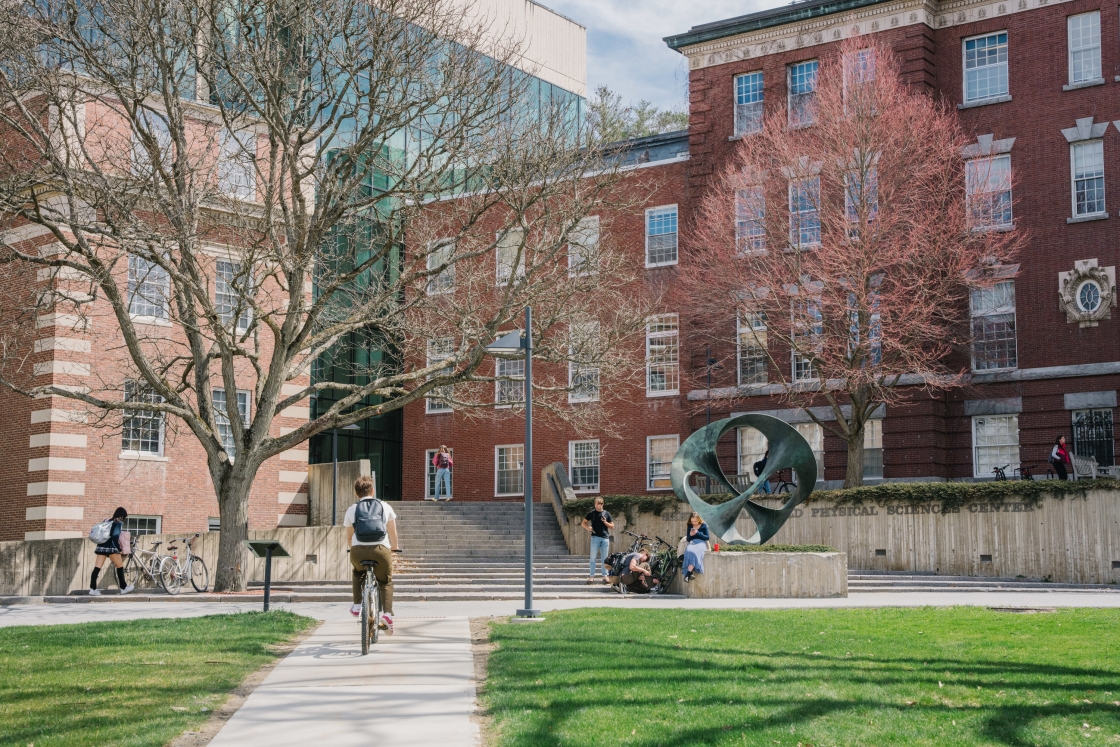Dartmouth is embarking on a path toward a low-carbon future with strategic investments in sustainable energy, waste management, food systems, land use, transportation, and water systems, President Phil Hanlon ’77 announced today.
“Over the past few years we have made historic investments to elevate our academic strengths in the areas of energy and the environment,” President Hanlon says. “Faculty and students in departments across campus and at the Arthur L. Irving Institute for Energy and Society teach and produce research related to energy and sustainability. This work will not only have a deep impact in the world beyond Dartmouth—it will also inform the approach we take to minimize our own environmental impact, globally and here in the Upper Valley.”
Dartmouth will take the following steps:
- Reduce greenhouse gas emissions from campus operations by 50 percent by 2025, and by 80 percent by 2050;
- Transition the campus heating system from No. 6 fuel oil to renewable sources by 2025;
- Establish a better system to distribute energy across campus, improving efficiency by 20 percent;
- Conduct a study, led by Executive Vice President Rick Mills, to determine optimal ways to reduce waste on campus;
- Convene a team of students, faculty, and staff to recommend ways to educate the community about the environmental impact of individual food choices;
- Form a sustainability corps of student analysts who will work with the Office of Sustainability to prioritize and conduct measurement and assessment studies to track progress toward sustainability benchmarks.
This plan of action takes into account recommendations made by a task force Hanlon convened a year ago, on Earth Day 2016. In its report, the interdisciplinary group of faculty, students, and staff proposes weaning the College from fossil fuels, among other strategies to shrink Dartmouth’s carbon footprint.
Dartmouth has already made progress toward more sustainable energy use. In 2010, according to the report, the College burned about 4.5 million gallons of No. 6 fuel oil. In 2016, it burned 3.5 million gallons. Annual absolute emissions have declined about 10 percent since 2011, even as about 30,000 square feet of new space was added to campus facilities. Seven College buildings have earned LEED certification for green design, and the recently launched Irving Institute will be housed in a new building that will serve as a teaching model of energy efficiency.
Those gains are real, the task force report notes, but more work needs to be done to improve resiliency. Task force co-chair Andrew Friedland, the Richard and Jane Pearl Professor in Environmental Studies, welcomes Hanlon’s commitment to the sustainable management of energy, food, water, waste, and land on campus—and to research that could benefit other communities, as well. “I am hopeful that this will build on our successes thus far, and be the continuation of a move toward enhanced sustainability actions in operations and in teaching and scholarship at Dartmouth,” Friedland says.
Task force co-chair Rosi Kerr ’97, Dartmouth’s director of sustainability, sees the action plan as “transformative for our campus. These goals are an opportunity to seek creative, cost-effective ways to reduce our impact. They also align us with the goals of the Town of Hanover, where local residents have also committed to work toward a low-carbon, environmentally responsible future.”
Hanlon is asking the Dartmouth community to participate in the energy-saving work that lies ahead. “I encourage each of you to read the report, consider how you can contribute, and join me and the full Dartmouth community as we strive to build a sustainable future for all.”


